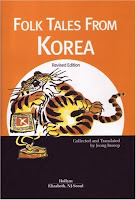Today I continue the blog series titled Following folktales around the world! If you would like to know what the series is all about, you can find the introduction post here. You can find all posts here, or you can follow the series on Facebook!
I didn't manage to find a folktale collection from North Korea, so I read this fascinating new article instead.
Hero of the People: Reimagining the Trickster in North KoreaCharles La Shure
The Journal of American Folklore, Vol. 133, No. 529, pp. 259-284.
The article explores how the North Korean regime uses a popular trickster figure from folklore, Kim Sondal, to broadcast its own message to the people through reframing old stories.
The beginning of the article introduces the Trickster archetype, then we get a short description to Korean trickster figures whose tales go all the way back to feudalism (14th to 19th centuries). Some of them are noblemen (which is rare for tricksters), some are clever servants, and Kim Sondal exists somewhere between the two. His tales are also popular in South Korea, but the character himself hails from Pyongyang, so North Koreans lay claim to him as local. This, by the way, serves as grounds for comparison (I'm curious to see if I'll read about him in the next book). It seems like North Korea has been publishing dozens of Kim Sondal story collections since the 90s, and even had some novels based on him. The main body of the article explores how these tales have been rewritten to fit propaganda, and brings some parallels from other nationalist movements and their relationship with folklore.
The tales
 |
There is even a movie in South
Korea about Kim Sondal |
In most of the North Korean tales Kim Sondal is a poor man oppressed by rich landlords. He is touched by the suffering of peasants, and uses his wits to trick greedy rich people and corrupt officials (who are often likened to pigs).
In one story Kim Sondal tricks a bunch of vain noblewomen into publicly confessing all their sins, and punishes the ones who had been cruel to their servants. Sometimes noblemen try to trap him, but they never succeed. Poor people like Kim Sondal so much that when he has to wander without food or shelter (because of the officials' cruelty) they feed him and shelter him - without him having to trick them into it.
I liked the story where Kim Sondal fed spoiled bean stew to a rich man, claiming it was rare gourmet 'fermented beans'. He also played the role of "fake fortune-teller", although here the moral of the story was that religion and spirituality are lies to trick the people. There was another popular tale about how the king closed all public toilets, so Kim Sondal was forced to use someone's private outhouse - and then refused to come out until he was paid.
The children's adaptations of the stories highlight the suffering of poor people, the evilness of the rich, and Kim Sondal's generosity to the former (he steals from the rich and gives to the poor, basically). They also add a lot of stuff against religion - for example, Kim Sondal openly denounces shamans (this carries on into the novels). Here, he wants to change he whole world by tricking the rich and build a new system where everyone is equal. Rich people are even more horrible, "barely human", and morals are clearly spelled out for the education of the children.
Connections
Comparing the stories to the South Korean versions it turns out that the southern Kim Sondal often tricks random people, instead of noblemen who deserve it. He usually does so for his own fortune and entertainment. He especially likes tricking the blind, and while in North Korean versions these blind people are "evil money lenders", in the South they are simply an easy target for the trickster. He also tricks monks sometimes, but not usually because of their religion. The structure of many tales is the same, but the motivations vastly differ in the North and the South.
According to the author, North Korean Kim Sondal, who serves the system, can't be called a trickster because he is not an ambivalent, liminal, rule-defying character anymore. He became some kind of a propagandistic culture hero, re-drawn even stronger with every adaptation.
Where to next?
South Korea!
























